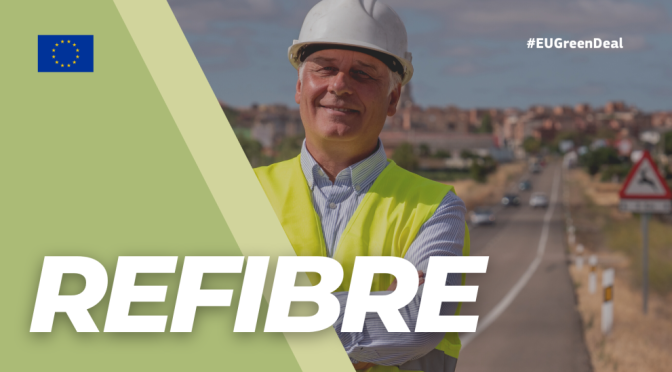The LIFE REFIBRE project transforms disused wind turbine blades into glass fibers that, once added to asphalt, make roads up to 30% more durable.
93.6% of the electricity demand in Castilla y León is covered with energy that comes from the wind. According to the latest data from the Wind Business Association, our community is the one with the largest installed wind power. Spain, for its part, is the fifth power in the world and the second in Europe in energy generated through windmills or wind turbines. We have 1,298 wind farms and a total of 21,574 wind turbines. But what happens to the blades of these mills when they reach their useful life? They have probably never wondered, however, its management represents an environmental problem of more than 220,000 tons that will end up becoming waste accumulated in landfills.
Road surface becomes 30% stronger thanks to recycled shovels
It is an issue that was already worrying the sector and that, by chance, Jorge de Blas, technical director of the construction company Blasgon, discovered: «we belong to an innovation group. We were going to meet, as usual, but I made a mistake and entered a meeting of a group of companies dedicated to the windmill sector, where they ended up raising this problem. At that moment I thought that this material inside a road surface could come in very handy”.
This is how the LIFE REFIBRE project arose, from the union of five entities: the Construction Institute of Castilla y León (ICCL), the CARTIF Technology Center, the engineering and consulting company Incosa and the construction companies Blasgon and San Gregorio. Together they have designed and built a system that transforms disused wind turbine blades into fiberglass that, once added to asphalt, makes roads up to 30% more durable. In this way, they have not only managed to give a second life to the huge blades of windmills, but also to improve the properties of the roads. The first test has been carried out on a stretch of road of just over a kilometer that connects the A-11 motorway with Toro.
A viable project thanks to EU funding
«We are SMEs in a sector that is tremendously mature and competitive, therefore, we have very limited resources to dedicate to innovation. If it hadn’t been for the EU funding, we wouldn’t have been able to move forward”, highlights Álvaro Oliver, managing director of San Gregorio.
REFIBRE – photo
Felipe Romero, project coordinator, in the stretch of road that connects the A-11 with Toro
Felipe Romero, technical director of the ICCL and coordinator of the project, details the process of applying for a financing program from the European Union. Why did you decide to apply for LIFE’s help?
In the first place, it offered us a decisive percentage of financing to ensure the viability of the project. Secondly, because the LIFE call is of a high level. Linking the idea of developing these new materials to the program was a guarantee of quality for us.
"The EU LIFE program offered us a decisive percentage of financing to ensure the viability of the project"Has the support of the EU influenced your situation?
So much so that we are considering the creation of a company specifically intended for the commercial exploitation of the results of the project. It has been a complex process in itself, but at the same time very rewarding because we have learned a lot from each other. Having an institutionalized experience has made us see R+D+i in a different way and establish it within our culture. It has provided us with very relevant knowledge in order to achieve new projects.
How does the commitment to innovative projects like this benefit Castilla y León?
It is very important for the region to develop a network of companies that are at the forefront of each of its activities and that help, in turn, to attract EU resources. Therefore, it is a fundamental commitment so that the projects remain in the region, helping, among other things, to retain talent.
Four pieces of advice for any entity that considers opting for these aids
Have a clear idea of the project and a very specific challenge.
Have professional support for the development of the project.
As it is a call that does not cover all the necessary investment, it must be ensured that there is also sufficient private financing.
Have an expectation of commercial use from the beginning of the project.EU funding opportunities for innovators
There are many SMEs, start-ups and innovative entities that have made their projects a reality thanks to the European Union.Search for available translations of the previous linkEN•••
The CEI Accelerator offers SMEs, start-ups and entrepreneurs the possibility of accessing grants of up to 2.5 million euros to finance projects


